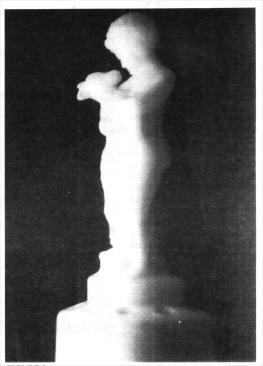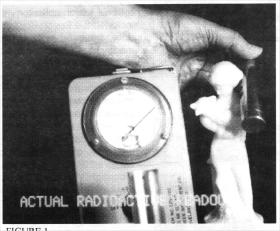The Glad and Sad Parts of Collecting -- Part II: Radioactive Cambridge Glass
by Joseph A. A. Borque, Sr.
Issue 298 - February 1998
Dear Reader,
During the turn of this century some glass manufacturers used radioactive materials in order to obtain certain colors for their glass prcducts The Cambridge Glass Company of Ohio was no exception to this practice.
December 1997's issue of the Crystal Bail carried my article about a most striking three-piece table center set in the not too common Cobalt-1 color. Its production was quite limited. These three pieces were made circa 1925, and are radioactive. though they are emitting weak signals 0.05 to 0.11 mR/hr) which, according to U.S. Department of Health standards, does not pose a hazard.
In the early or middle 70s, I teamed up with a chemist whose name was Sam. He worked out of a Boston office for the U.S. Health, Education and Welfare Department. Together we conducted a general glass survey regarding radioactive glass - which took us about two years. At that time my wife, Ann, had a pretty large antique and collectibles shop in Salem, New Hampshire.
I first met Sam when he entered Ann's shop, picked up a Cambridge green sandwich server with center handle, looked at me and stated, "Do you know that this piece of glass is radioaotive?" I was somewhat taken aback by the abruptness of the matter, but managed to smile back as I said something like. "1 think you may be right." He retorted, "I'm serious!" "And so am I" said I. This was the beginning or a good friendship that lasted two years until Sam got into an accident which caused him to return to his native Texas.
Sam thought he was revealing a secret to me, but what he did not know was that in the shop I had set up one large oaken/glass case counter that was 10 feet long and one yard deep with hundreds of pieces of Akr0 Agate glassware and toy marbles by the boxful. I was an avid collector of Akro. Every single item in that cabinet was fully or partly radioactive Akro glass. As I stood behind this cabinet I beckoned Sam to come on over, which he did, standing diraotly in front of this panorama of varicolored marbleized Depression gloss. "I"m going to put the lights out for a minute or so to show you something," I informed Sam, The headlights went out, and quickly lit up six secreted large ultraviolet hanging lights within the cabinet. The radioactive Akroware erupted in bright fluorescing radiations of many bright colors! Sam, who least expected this phenomena to happen, took one large step backwards, and very slowly and quietly kept uttering one word, "Awesome." And even I had to admit, it was!
We introduced ourselves and right there and then we cemented a friendship. Sam placed the green Cambridge sandwich serverwith center handle, which he had held in his hands, close to the UV lights. it fluoresced a fiery-green. I brought Sam a Geiger counter, and he tested it to see if it was radioactive. It was, and I still have it somewhere in storage. Thus began a two-year survey of radioactive glass.
If you do not have a good UV light, I recommend you do. It will make you a better student of glass. I purchased my first UV light after reading an article in the Antique Magazine about using UV rays to discover repairs on glass. Some glues fluoresced. I started UV-ing everything I could lay my hands on. It wasn't too long before I started to notice that some glasses, Akro. Cambridge, especially toy marble companies, and several other manufacturers of green and so-called canary glass, made glass that fluoresced very brightly.
I retired from the military in 1965. My training in the military taught me a few things about radioactivity. Sometime in I966-67 I theorized that these bright colors I was seeing with the UV light could be "hot" (radioactive). I purchased my first Geiger counter in 1967. I recalled having read that a tableware called Fiesta-red was radioactive, and a sure way of testing for radioactive material was to use a Geiger counter.
 After we finished our survey, Sam parted the New England area with
his notes (for HEW). I still have my notes. A few years later, I think
about the mid-1970S, I wrote an article about radioactive glass for the
late Nora Koch, owner and editor of the Daze. She was one of
fhe two pioneers of collecting and marketing Depression Era Glass
(DEG); the other being the late Hazel Marie Weatherman, author of
various DEG books. Mrs. Weatherman was able to witness my cabinet of
radioactive Akro glass at my wife's shop. She was impressed with this
phenomena, and I gave her some shards I had dug up at the Akro site in
1971. My article on radioactive glass to Mrs. Koch was written circa
1974.
After we finished our survey, Sam parted the New England area with
his notes (for HEW). I still have my notes. A few years later, I think
about the mid-1970S, I wrote an article about radioactive glass for the
late Nora Koch, owner and editor of the Daze. She was one of
fhe two pioneers of collecting and marketing Depression Era Glass
(DEG); the other being the late Hazel Marie Weatherman, author of
various DEG books. Mrs. Weatherman was able to witness my cabinet of
radioactive Akro glass at my wife's shop. She was impressed with this
phenomena, and I gave her some shards I had dug up at the Akro site in
1971. My article on radioactive glass to Mrs. Koch was written circa
1974.
I will not attempt to write down everything Sam and I did at this stage, but will make a general statement that several glass houses made radioactive glass during the 1920s and 1930s, and as previously stated, Cambridge was not excluded.
 I should like to point out a quote from the Colors In Cambridge
Glass book by our own National Cambridge Collectors Inc., page 38:
"Cobalt Blue I is a medium blue, It is the lightest of the twp cobalts
of the 1920s and can usually be distinguished from the other with the
naked eye ... Under black light, Cobalt Blue 1 is highly fluorescent
whereas the other cobalt shows little or no fluorescence."
I should like to point out a quote from the Colors In Cambridge
Glass book by our own National Cambridge Collectors Inc., page 38:
"Cobalt Blue I is a medium blue, It is the lightest of the twp cobalts
of the 1920s and can usually be distinguished from the other with the
naked eye ... Under black light, Cobalt Blue 1 is highly fluorescent
whereas the other cobalt shows little or no fluorescence."
Some Cambridge glass emits more radioactive rays than others. I photographed a Two-Kid flower holder in Ivory in the darkness less the unseen rays of UV light (photo at right), and one in full light while being measured with a Geiger counter. (photo at left).
TO BE CONTINUED ...
'Til next time,
Joe
